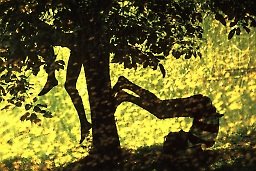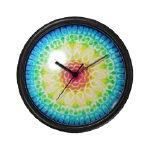The “new normal” is a phrase I run across sometimes in the CLL community. It’s shorthand for what things are like when you are living with the disease. For all of us, the new normal means accepting that we have leukemia, and that this may shorten our lives.
Beyond that, the new normal can vary. Indeed, it is always changing or threatening to change.
For newbies, the new normal may mean coping with shock, traversing the unfamiliar terrain of prognostic tes ting and blood drawing and busy oncology offices where women with bald heads sit in chairs, their arms linked to bags of fluid on IV poles. The new normal can mean sorting out who your friends really are, who your mate really is, what kind of a work environment you really have -- and that perennial CLL rite of passage, figuring out if your doctor knows his ass from a hole in the ground. It can be stressful and bumpy and yet perhaps strangely exhilarating. After all, when looking mortality in the face, even with a sideways glance, one can sometimes put things in perspective and find ways to live more meaningfully. So, for some, the new normal can be transformative in a good way at the same time that it is fearsome as hell. The new normal is contradictory, and often surreal.
ting and blood drawing and busy oncology offices where women with bald heads sit in chairs, their arms linked to bags of fluid on IV poles. The new normal can mean sorting out who your friends really are, who your mate really is, what kind of a work environment you really have -- and that perennial CLL rite of passage, figuring out if your doctor knows his ass from a hole in the ground. It can be stressful and bumpy and yet perhaps strangely exhilarating. After all, when looking mortality in the face, even with a sideways glance, one can sometimes put things in perspective and find ways to live more meaningfully. So, for some, the new normal can be transformative in a good way at the same time that it is fearsome as hell. The new normal is contradictory, and often surreal.
For patients like myself who are past the newbie stage and whose disease is progressing, the new normal can mean arranging your time and finances around visits with e xperts, who often contradict one another. It can mean serious study about treatment options, none of which is without risk. This new normal means living with a higher level of risk -- risk that the disease could take off even faster if something is not done, or if something particular is done. It means a little more anxiety within the family, an end to the lingering sense of security new patients often enjoy. “Watch and wait” becomes a serious affair and can be akin to sitting in a foxhole not knowing when the first shell will land. In this new normal, time can begin to take on the element of a luxury. For many it is accompanied by symptoms -- fatigue, infections, night sweats, lymph nodes that have grown big enough to hurt, spleens that twinge in the night.
xperts, who often contradict one another. It can mean serious study about treatment options, none of which is without risk. This new normal means living with a higher level of risk -- risk that the disease could take off even faster if something is not done, or if something particular is done. It means a little more anxiety within the family, an end to the lingering sense of security new patients often enjoy. “Watch and wait” becomes a serious affair and can be akin to sitting in a foxhole not knowing when the first shell will land. In this new normal, time can begin to take on the element of a luxury. For many it is accompanied by symptoms -- fatigue, infections, night sweats, lymph nodes that have grown big enough to hurt, spleens that twinge in the night.
For patients who are at later stages than I, I imagine the new normal can be all-consuming. Heavy-duty treatment, and recovery from that treatment, or complications from that treatment, or the failure of that treatment, all may bring an element of emergency to having CLL that was  missing before. Wondering what in God's name is next, searching for something that might work, spending tens of thousands of dollars to find a perfect bone marrow donor, fighting insurance companies, all can be rolled into a ball in which the new normal is little more than a constant state of anxiety -- anxiety carried with you on the proverbial emotional roller coaster with its exhausting ups and downs. For those who have undergone transplants, graft versus host disease is a constant reminder of where the journey has led. And for some, perhaps, the success of a transplant may mean, at long last, the easing of fear, the release of the dragon, a profound relaxation. At any point in the journey, we all enjoy remissions. So successful chemotherapy, too, can restore life almost to its original gait -- until the sword of Damocles returns again from the mist.
missing before. Wondering what in God's name is next, searching for something that might work, spending tens of thousands of dollars to find a perfect bone marrow donor, fighting insurance companies, all can be rolled into a ball in which the new normal is little more than a constant state of anxiety -- anxiety carried with you on the proverbial emotional roller coaster with its exhausting ups and downs. For those who have undergone transplants, graft versus host disease is a constant reminder of where the journey has led. And for some, perhaps, the success of a transplant may mean, at long last, the easing of fear, the release of the dragon, a profound relaxation. At any point in the journey, we all enjoy remissions. So successful chemotherapy, too, can restore life almost to its original gait -- until the sword of Damocles returns again from the mist.
And for those less fortunate, for whom the last options have failed, the new normal can mean acceptance that the battle has ended, entry into hospice, precious time spent with loved ones, and then a journey none of us know, but which is likely to be far from anything that seems normal here on Earth.
What is clear from all these stages of the new normal is that once you have enter ed this world you can never truly go back to the old normal, what life was before diagnosis.
ed this world you can never truly go back to the old normal, what life was before diagnosis.
Learning to navigate the new normal can be quite a challenge. Some are alarmed at the first appearance of a pea-sized lymph node, and then they get used to it, and then the lymph node becomes almond-sized. This leads to a bit more anxiety, perhaps a doctor visit, heightened watch-and-wait. Eventually, one can learn that two dozen swollen lymph nodes are the new normal, some as big as a golf ball, some causing pressure or pain. A once-slim neck becomes chunky, the limits of one’s vanity get tested when one is seen in public. The new normal means showing signs that others can see that something is wrong. And yet life goes on, the dog needs walking, the rose bush needs pruning, the bills need paying, the kids or grandkids have birthdays that need celebrating.
In the new normal, time moves both faster and slower. Faster in the sense that there may be less of it th an planned, slower in that for many people the adage “be here now” begins to happen, often for the first time. Yet, as much as the new normal can be a place of spiritual growth, or growth by tapping inner resources you didn’t know you had, it can also be a depressing place. For some, this means taking antidepressants, or just dealing with perceived doom through layers of gloom. There are moments, common to us all, when we just sit back and sigh and realize, once again, what a bitch it is to have CLL.
an planned, slower in that for many people the adage “be here now” begins to happen, often for the first time. Yet, as much as the new normal can be a place of spiritual growth, or growth by tapping inner resources you didn’t know you had, it can also be a depressing place. For some, this means taking antidepressants, or just dealing with perceived doom through layers of gloom. There are moments, common to us all, when we just sit back and sigh and realize, once again, what a bitch it is to have CLL.
Learning what the new normal is for me has been a challenge, and will no doubt continue to be. As readers may know, I have been searching for the next step in my treatment, and for some broader sense of my long-term treatment plan. I have consulted now with four CLL experts, most recently John Byrd at the James Cancer Center at Ohio State University. In The "new normal," Part 2, I will tell you what I have learned along the way, and what I have concluded -- at least for now, until the new normal changes again.





7 comments:
Thank you David.
With great repect,
Carlin
Sorry, one of my challenges has always been spelling.
I end with great respect.
I enjoy so very much what you choose to write about and how you make words magic!
Carlin C.
David-
Great way to explain all the emotional gumbo with the new normal. As a musician, I call it the "new rhythm". Learning to dance to a different beat. I tried for over a year to go back to life as I knew it, only to learn that it was impossible. The drum beat has changed and there is no coda.
David,
What a great gift of the written word you have to be able to express so clearly the broad range of experiences and emotions with which we are dealing. What a crazy journey we are on that is filled with frustration, sometimes fear, and yes, (dare I say?) blessings.
Thank you.
You truly have a gift with words and as someone only diagnosed in Mar2006 I have quickly figured out that life is now different forever. Not bad necessarily but surely and truly different. I will keep reading your thoughts and wander back through the archives. Thank you!!
David
You really have a knack for writing. Your comments are so interesting. I have a question about your ZAP-70 test. You stated that it was positive. I recently recieved the results of my ZAP-70 test and it revealed that I was low positive (11%). I was under the impression from my reading that below 20% was negative. Can you clarify this for me?
Thankyou
Bob
Bob,
The ZAP-70 cutoff varies from lab to lab, as does the quality of the test. I am guessing you may have had your test through Quest. Quest uses 10% as a cutoff for shipped samples -- I think they use 15% for non-shipped. I got such varying numbers from Quest over the course of three different ZAP-70 tests that I think Quest is probably unreliable. I finally went to UCSD (see my "Foggy San Diego" posts), where the lab is known to be THE place to have the test done, and it came out definitely positive. Quest had me at 8% -- UCSD had me at 83%!!!!
Based upon what I have heard from any number of experts, both in person and in my reading on the net, the testing methods for ZAP-70 in commercial labs are still unreliable, so much so that the test is virtually worthless in those hands.
IgVH mutational status, FISH and CD 38 are still the most reliable tests and markers.
David
Post a Comment